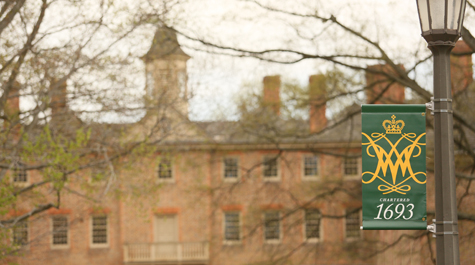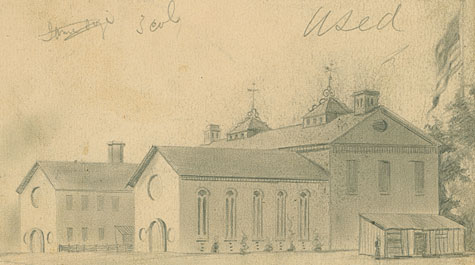The Wren: You know the building; what about its history?
The Sir Christopher Wren Building stands at the heart of the William & Mary campus - literally and figuratively. Originally known as simply "The College Building," the structure is the symbol of the university's 322-year history. Still, there may be a few things not everyone knows about this iconic structure.
Ten things you may not know about the Wren
1. Doors Closed. The Wren, the oldest college building in the U.S., has not been in continuous use. It was closed during both the Revolution and the Civil War and during the Silent Years of 1880-1888 when the entire university was closed. The Wren was used as a field hospital during both the Revolution and Civil War.
This Civil War era sketch, known as the Taylor Drawing, was aquired by the university in 2011. Courtesy Swem Special Collections Research Center.
2. Ghosts on the rafters. There are several architectural “ghosts” visible today on the façade of the Wren – the sites of former windows in the Great Hall when the space was divided into two floors, the shadow of the towers that graced the east front from 1859 to 1862 and traces of 19th-century windows on the north and south ends of the east facade.
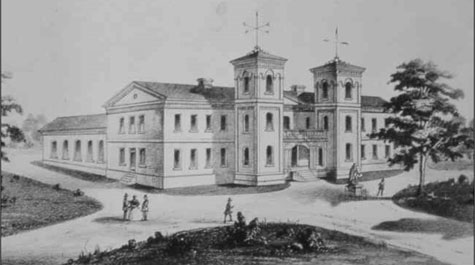
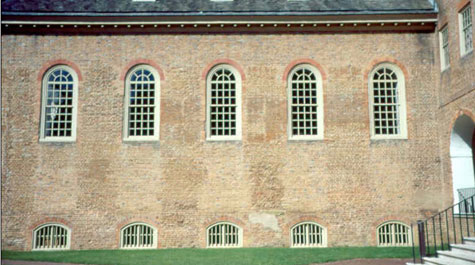
Above images courtesy of Swem Special Collections (towers photo and the Great Hall image) and the Richmond Times-Dispatch (towers photo).
3. Aim. Fire. On the east front, just below the second window from center on the main floor, several musket holes remain from a skirmish of the Civil War.
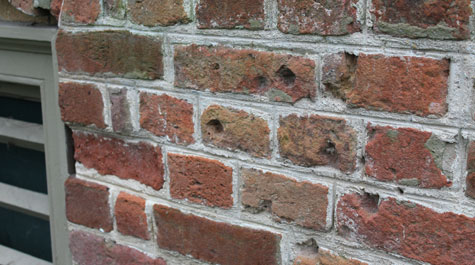
Photo by Suzanne Seurattan.
4. Foundations of history. The cornerstone of the College was laid on Aug. 8, 1695. No images of the cornerstone are known to exist. Hmm ... wonder if Lord B. knows where it is?
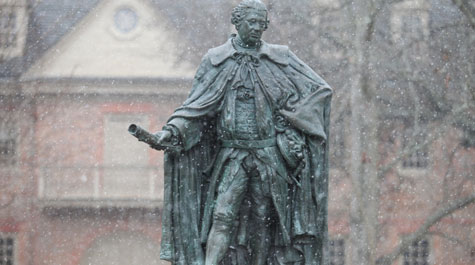
Photo of Lord Botetourt statue by Stephen Salpukas.
5. Not really our organ. Despite being commonly referred to as the “Wren” Organ, the 18th-century instrument doesn’t actually belong to the university. It is on loan from Colonial Williamsburg. The organ, among the four oldest in the United States, was bought in England by Colonial Williamsburg in 1954 and imported to America to reside in the ballroom of the Governor's Palace, which is adjacent to the college in Williamsburg. In 1963, Colonial Williamsburg moved it to a hallway in the Williamsburg Lodge where it stood for several years as a silent piece of furniture. In 1970, it was placed into the balcony of Wren Chapel. Today it is used regularly for concerts (Saturday mornings at 10 a.m. during the school year), recitals, weddings and other functions. While this organ may not belong to William & Mary, there is an 1806 record of repairing an organ at the College - evidence that the chapel may have had another organ in the past.
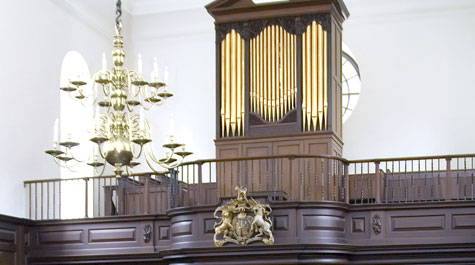
Image: file photo.
6. Wedding date. It is a myth that the Wren Chapel is booked for weddings five years in advance. In reality, staff are only permitted to book weddings about a year in advance because they have to wait for the university calendar to be set each year. In fact, in 2014 a groom planned a surprise wedding for his bride in just a few weeks.
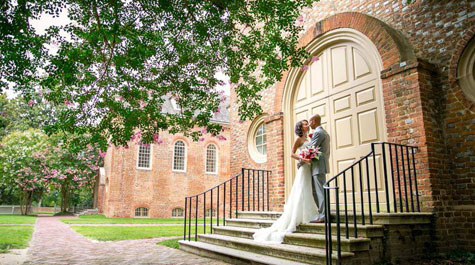
Image: Courtesy photo of Nicky Hutchison and "surprise" bride Lisa Marie Scott on the steps of the Wren Chapel. Photo by David Champagne.
7. What’s in a name? The Sir Christopher Wren Building is the modern name for the building. It was selected in the 1930s during the Colonial Williamsburg restoration of the building and was based on a reference from Hugh Jones, an 18th-century professor. The original name for the building was the College Building. Its 19th century name was the Main Building. The university doesn’t actually have any proof that the Sir Christopher Wren Building was designed by Wren. The only attribution to Wren is Jones's journal. He wrote of this later, around the time of Wren’s death when it was popular to attribute things to Wren. Jones would have been a mere toddler in England around the time Wren (or whoever it was) actually designed the building we know of today as the Wren Building.
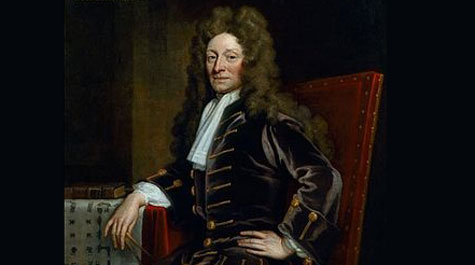
Image: web image of Godfrey Kneller painting of Wren (1711).
8. Original schools. The College Building (today’s Wren) housed William & Mary’s four original schools: the grammar school, the college, the graduate program of divinity for young men studying to become Anglican ministers and the American Indian school, until the Brafferton was built for the Indian students in 1723. The Indian School, for which James Blair lined up funding before even getting the King & Queen to sign the charter for the College – and which greatly contributed to the King & Queen’s signing of the royal charter – met in the College Building's Grammar School classroom for several decades until their own building was built.
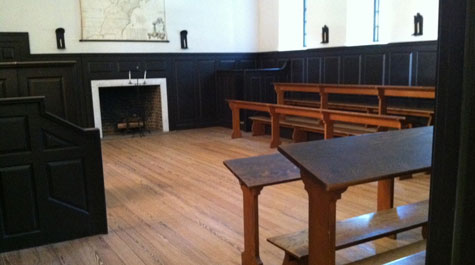
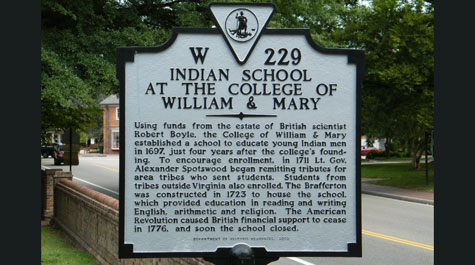
Images: Grammar School photo by Kimberly Renner and Indian School marker web image courtesy of markerhistory.com.
9. Which way is front? Many W&M students think the west side of the Wren facing the Sunken Garden is the front, but that is the back of the Wren. The Wren faces east toward Duke of Gloucester Street and the City of Williamsburg.
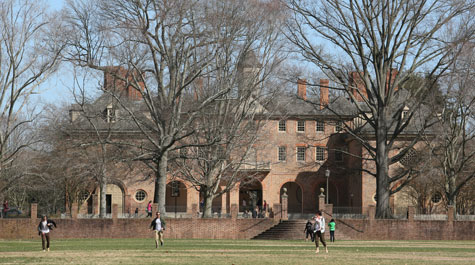
Image: The Sir Christopher Wren Building (West Front) by Stephen Salpukas.
10. Charter Day excitement. The 1859 fire of the College Building happened on Charter Day, February 8, 1859. The fire was devastating. Many details of the fire were included in local press accounts. From these accounts, we understand the fire started in the cellar beneath the Great Hall wing, which housed the chemistry lab and the library. According to news reports of the time, the blaze lit up the night sky and was visible from cities surrounding Williamsburg. The windows from that wing exploded outward and the glass debris from them is found much further from the building by modern archaeologists than initially thought. The building was gutted but rebuilt very quickly; it was up and running by that Christmas. A history of each of the Wren's three fires is on display in the Wren Visitor Center.
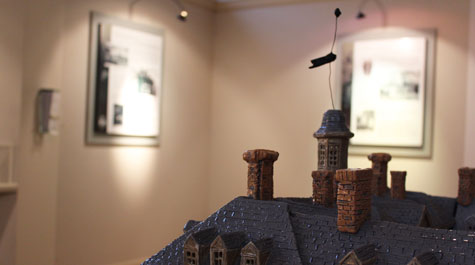
Image: The Wren Visitor Center by Suzanne Seurattan.
 Skip to main content
Skip to main content

